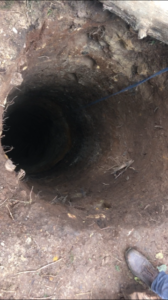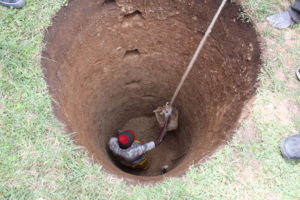
Constructing a hand-dug well is far more than just shoveling dirt … today, intern Kendall Prossner documents the painstaking process.
Today was (surprise!) a travel day! We left our hotel in Hawassa early this morning and drove back to Addis, which allowed us to see some new parts of Ethiopia. Along the way we saw some huge monkeys, lots of dogs, and like always, more donkeys, goats, and sheep than you could imagine. Since most of the roads were paved we missed out on our African massages, but that meant everyone was able to get some much-needed shuteye.
 After our four-hour drive back to the city, we were able to visit a site that sits at the very top of a mountain – Ashi got us most of the way there in the truck, and then we had a short but steep hike up to the site. This is a hand-dug well site and is one that is currently under construction for the third time. The first well didn’t strike water and the second well CAVED IN WHILE THEY WERE DIGGING IT. I have so much respect for the well diggers who continually descend several meters to hand dig a well for their community. This is not a job for the faint-hearted.
After our four-hour drive back to the city, we were able to visit a site that sits at the very top of a mountain – Ashi got us most of the way there in the truck, and then we had a short but steep hike up to the site. This is a hand-dug well site and is one that is currently under construction for the third time. The first well didn’t strike water and the second well CAVED IN WHILE THEY WERE DIGGING IT. I have so much respect for the well diggers who continually descend several meters to hand dig a well for their community. This is not a job for the faint-hearted.
As I mentioned, these hand dug wells can cave in at any moment – something that can prove to be deadly to the digger at the bottom. The well we visited today I could swear was never ending. One of the site engineers tried to hold my arm so I could lean over and look in to see the digger at the bottom. Let’s just say, I don’t know what he looks like.

This site is just one of the hundreds of hand dug wells that brave diggers choose to develop for their communities. We’ve visited countless other communities, and I’m sure we’ll visit several more, that have sites that have been or are being dug out by hand.
Hand-dug wells are just one of the types of wells Water to Thrive uses. To give you an idea of how construction for this type of well works, these guys literally hand dig the well, put dirt into buckets that people pull up to dump out, and make little notches in the sides as seen below to have as a make-shift ladder so they can ascend and descend into/out of the well.

Once the digger strikes water, it is required for them to use a dewatering pump to remove water so they can continue to dig deeper into the aquifer. This is an extremely important step in the process because it ensures that they’ve gone deep enough in the aquifer that people will have water even during the dry seasons. After measuring the depth of the water and making sure it’s a reliable source for all seasons, concrete rings are put in place and a base plug is put at the bottom of the well. The base plug’s job is to seal the well and filter out fine materials that might enter through the intake. The well shaft is then sealed and gravel packing fills the voids between the excavated sides and the concrete rings up until 3m from the surface. For the final three meters, clay is used to fill the voids to ensure that surface water doesn’t seep into the well shaft and possibly contaminate the clean water. Finally, the well is sealed and the pump head is fitted and installed.
After hearing about how these wells are constructed, it’s impossible to forget that none of that would be possible without brave well diggers that are willing to risk their lives so their community can have safe, clean water.



About The Author: Water to Thrive
More posts by Water to Thrive